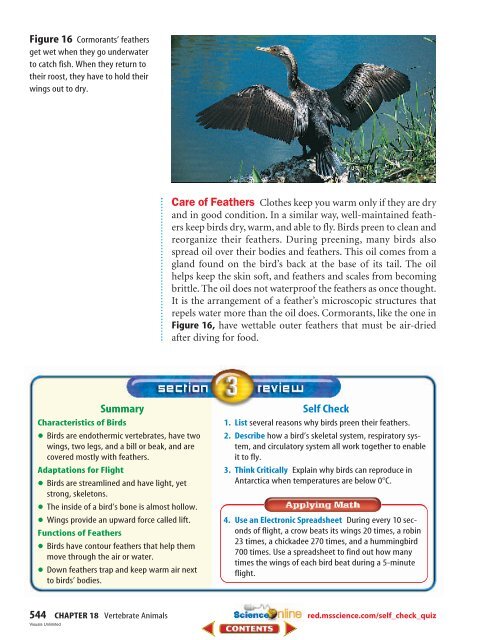Chapter 18: Vertebrate Animals
Chapter 18: Vertebrate Animals
Chapter 18: Vertebrate Animals
You also want an ePaper? Increase the reach of your titles
YUMPU automatically turns print PDFs into web optimized ePapers that Google loves.
Figure 16 Cormorants’ feathers<br />
get wet when they go underwater<br />
to catch fish. When they return to<br />
their roost, they have to hold their<br />
wings out to dry.<br />
Care of Feathers Clothes keep you warm only if they are dry<br />
and in good condition. In a similar way, well-maintained feathers<br />
keep birds dry, warm, and able to fly. Birds preen to clean and<br />
reorganize their feathers. During preening, many birds also<br />
spread oil over their bodies and feathers. This oil comes from a<br />
gland found on the bird’s back at the base of its tail. The oil<br />
helps keep the skin soft, and feathers and scales from becoming<br />
brittle. The oil does not waterproof the feathers as once thought.<br />
It is the arrangement of a feather’s microscopic structures that<br />
repels water more than the oil does. Cormorants, like the one in<br />
Figure 16, have wettable outer feathers that must be air-dried<br />
after diving for food.<br />
Summary<br />
Characteristics<br />
•<br />
of Birds<br />
Birds are endothermic vertebrates, have two<br />
wings, two legs, and a bill or beak, and are<br />
covered mostly with feathers.<br />
•<br />
Adaptations for Flight<br />
Birds are streamlined and have light, yet<br />
strong, skeletons.<br />
•<br />
The inside of a bird’s bone is almost hollow.<br />
Wings provide an upward force called lift.<br />
•<br />
Functions of Feathers<br />
Birds have contour feathers that help them<br />
•<br />
move through the air or water.<br />
Down feathers trap and keep warm air next<br />
to birds’ bodies.<br />
Self Check<br />
1. List several reasons why birds preen their feathers.<br />
2. Describe how a bird’s skeletal system, respiratory system,<br />
and circulatory system all work together to enable<br />
it to fly.<br />
3. Think Critically Explain why birds can reproduce in<br />
Antarctica when temperatures are below 0°C.<br />
4. Use an Electronic Spreadsheet During every 10 seconds<br />
of flight, a crow beats its wings 20 times, a robin<br />
23 times, a chickadee 270 times, and a hummingbird<br />
700 times. Use a spreadsheet to find out how many<br />
times the wings of each bird beat during a 5-minute<br />
flight.<br />
544 CHAPTER <strong>18</strong> <strong>Vertebrate</strong> <strong>Animals</strong><br />
Visuals Unlimited<br />
red.msscience.com/self_check_quiz

















